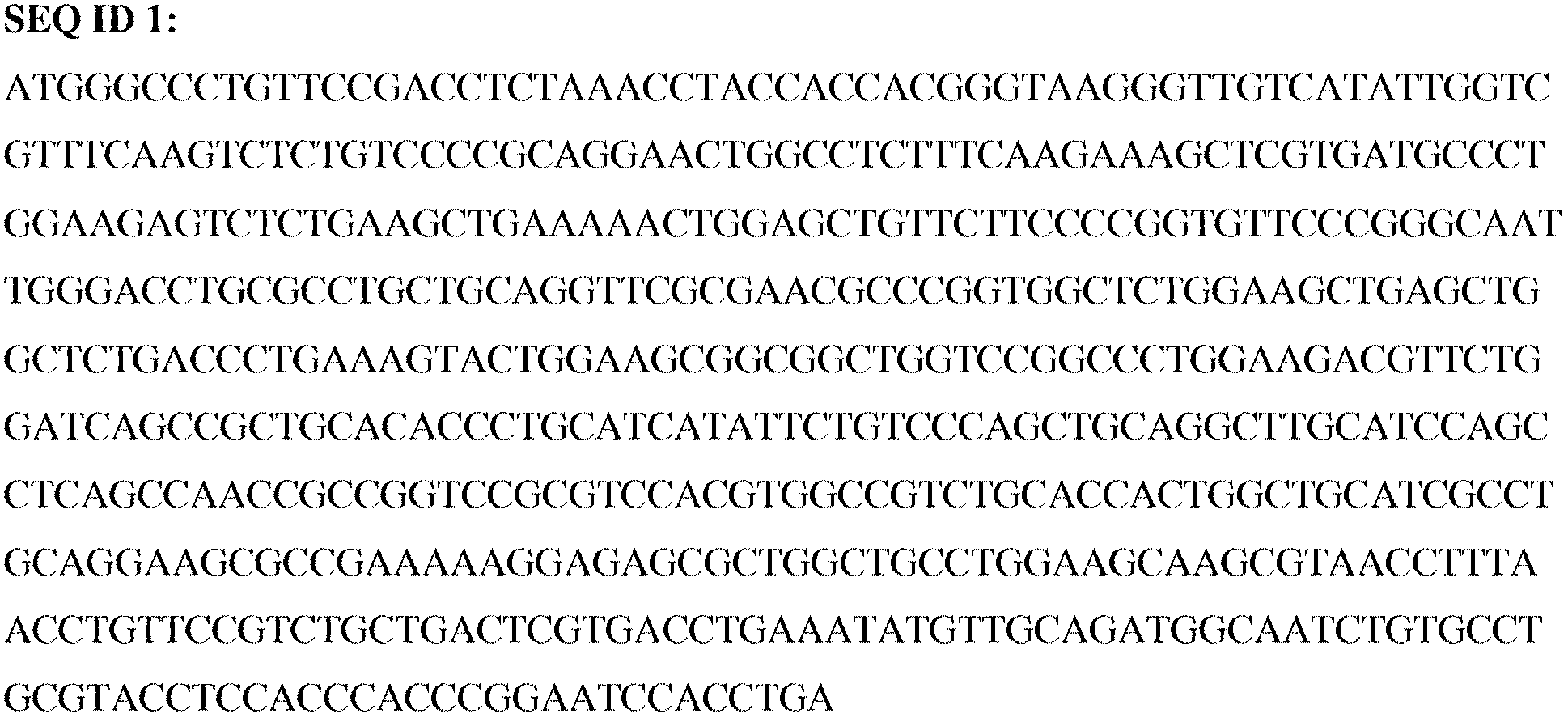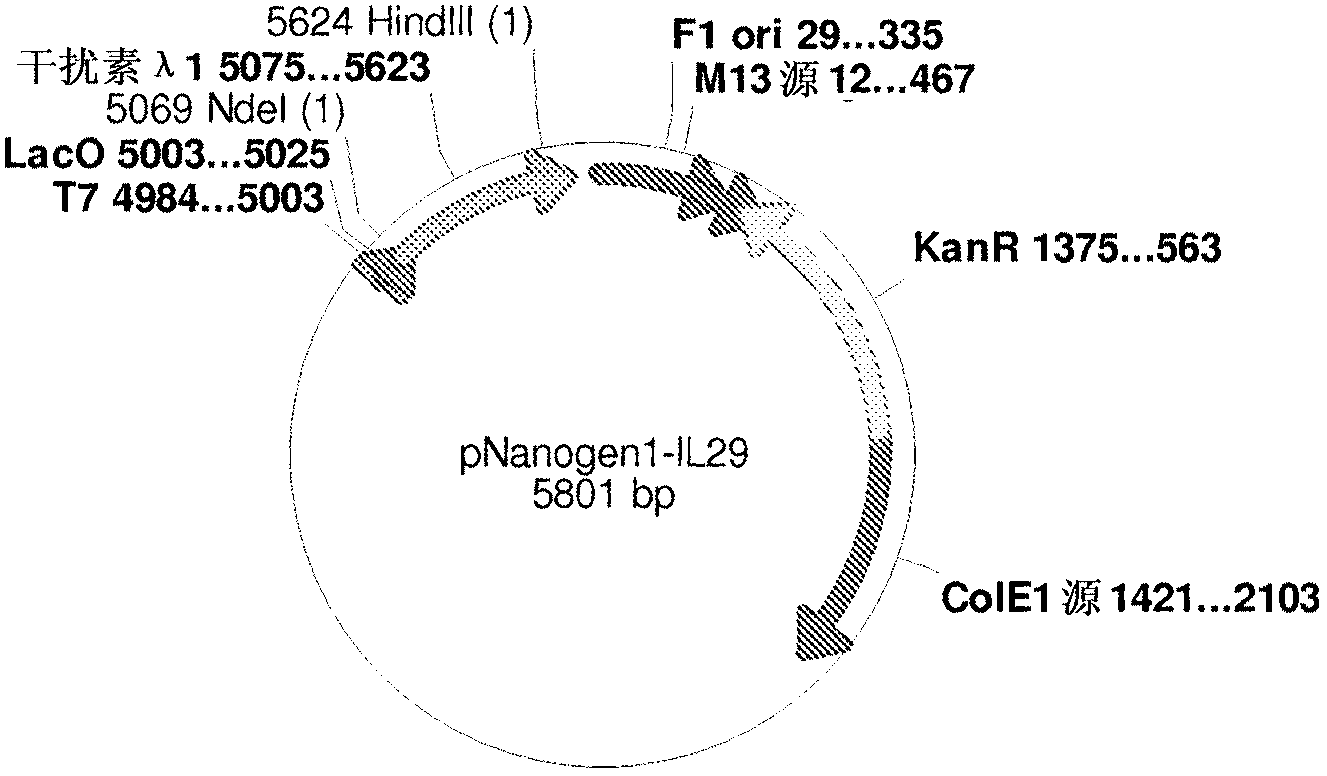PEG-interferon lambda 1 conjugates
A conjugate and interferon technology, applied in the direction of interferon, cytokine/lymphokine/interferon, drug combination, etc., can solve the problems of inconvenient treatment, expensive, short half-life, etc.
- Summary
- Abstract
- Description
- Claims
- Application Information
AI Technical Summary
Problems solved by technology
Method used
Image
Examples
Embodiment 1
[0072] Example 1: Method for preparing an Escherichia coli strain comprising a gene encoding human recombinant interferon λ1 (IFNλ1)
[0073] The gene encoding IFNλ1 was artificially synthesized based on protein sequence data available from NCBI or other databases. The new method presented here reduces the time required to isolate genes but still provides results as accurate as conventional methods. The nucleic acid sequence for producing IFNλ1 in Nanogen Pharmaceutical Biotechnology Co., Ltd. is as follows figure 1 The amino acid sequence of the protein is shown as figure 2 shown.
[0074] The expression vector pNanogen IL29 (including T7 transcriptional promoter region, IFNλ1 transgene, T7 reverse promoter site, T7 transcriptional terminator, f1 promoter (origin), kanamycin resistance gene and replicated pUC promoter) is specially designed to The protein can be highly expressed to promote the fermentation of a large amount of IFNλ1 industrial production. image 3 , Fi...
Embodiment 2
[0076] Embodiment 2: the method for Escherichia coli fermentation production human recombinant IFNλ1
[0077] The fermentation process is carried out in a 140L fermenter with nutrient medium at a temperature of 37±0.5°C and an air pressure of 0.5m 3 / h, the pH is 7.0±0.2, the stirring rate is 300rpm, and by adding H 3 PO 4 or NH 4 OH keeps the pH between 6.8-7.2. After 8 hours (E. coli is in the logarithmic phase growth is the most effective time for cell growth), the temperature was cooled to 30±0.5°C, and the stirring speed was reduced to 200rpm to start the process of IFNλ1 production. The fermentation process was stopped after 4 hours and the cooled product was centrifuged at 6000 rpm to obtain biomass.
[0078]Biomass was disrupted in cell lysate (12 mL solution per 1 g wet biomass) by homogenization in a homogenization apparatus. The temperature was maintained at 4°C for 1 hour, and then the cells were disrupted 2 times by an ultrasonic device. The resulting suspen...
Embodiment 3
[0082] Example 3: Purification process of human recombinant IFNλ1
[0083] IFNλ1 was refolded by dissolving inclusion bodies in a refolding solution (25 mM Tris buffer, 1 mM EDTA, 1.2 M guanidine, pH 8.2) so that the final concentration of inclusion bodies was 500 μg / mL. The mixture was then kept at 2-8 °C for 16-24 h. The resulting mixture was subjected to a purification step on a Sephadex G25 column after desalting. The salt exchange buffer was phosphate buffer (10 mM, pH 8.0), and in step "Cation 1", the desalted mixture was loaded onto a Sephadex G25 column (the column was prepacked with CM-Sepharose FF gel and incubated at pH 8.0 Equilibrated in 10 mM phosphate buffer), use 10 mM sodium phosphate + 0.5 M NaCl (pH 8.0) to elute the product. The resulting protein solution was desalted and chromatographed as above (step "Cation 2"). The protein solution was then filtered through a gel column to obtain the product human recombinant IFNλ1 with a purity greater than 95% (see...
PUM
| Property | Measurement | Unit |
|---|---|---|
| molecular weight | aaaaa | aaaaa |
| molecular weight | aaaaa | aaaaa |
| weight | aaaaa | aaaaa |
Abstract
Description
Claims
Application Information
 Login to View More
Login to View More - R&D
- Intellectual Property
- Life Sciences
- Materials
- Tech Scout
- Unparalleled Data Quality
- Higher Quality Content
- 60% Fewer Hallucinations
Browse by: Latest US Patents, China's latest patents, Technical Efficacy Thesaurus, Application Domain, Technology Topic, Popular Technical Reports.
© 2025 PatSnap. All rights reserved.Legal|Privacy policy|Modern Slavery Act Transparency Statement|Sitemap|About US| Contact US: help@patsnap.com



